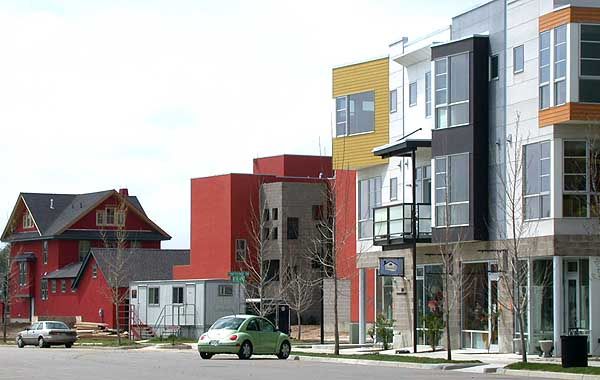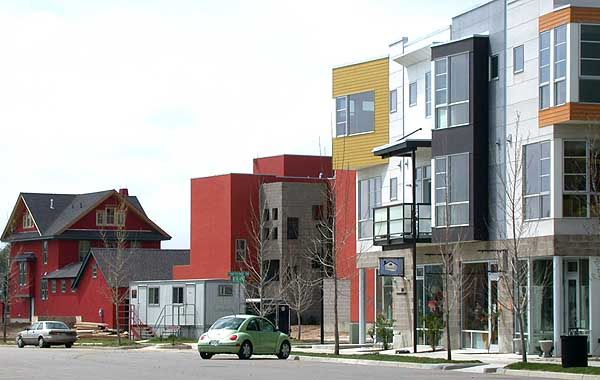
A client asked me to find out if the New Urbanism made sense from a product-placement perspective. In other words, did it make sense to court New Urbanist planners and developers, and adopt new products to their needs? The obvious answer seemed, yes, New Urbanism has established itself as the most successful brand of urban planning since tract-style, or conventional suburban developments exploded after World War II.
New Urbanism represents a back-to-the-future approach to modern development by reviving the town planning strategies that made the typical neighborhoods of the 18th and 19th centuries so appealing that many have become tourist destinations today, such as Williamsburg and Hilton Head. Many of us recognize the New Urbanism projects in town as those featuring neo-traditional housing styles, such as Federal-Adams and Italianate, with front porches and pilasters. But although most New Urbanism developments do embrace older housing styles, the concepts of the movement are not architectural so much as focused on the creation of human-scale, mixed-use, walkable communities.
A Successful and Ubiquitous Brand
Since its humble origins as a small group of likeminded planners and architects that coalesced in the early 1990s to form an organization, the New Urbanism has grown to have a substantial impact on real estate development internationaly, including nearly 1,000 new towns in the US, some of which are cataloged at the website of the Congress for the New Urbanism (CNU).
The only other organization that can claim as much influence on modern development is LEED, the green-building giant. In fact, the two organizations, CNU and LEED, often cooperate, such they have creating the now ubiquitous planning strategies of Smart Growth, Walkable Neighborhoods, Transit-Oriented Development, Form-Based Codes, and LEED for Neighborhood Design. The two movements these organizations represent, both New Urbanism and Green Building, also represnet the two approaches to design and construction that survived the Great Recession of 2008.
A Dearth of Data
So with all this in mind, I set out to find statistics for my client on impact of New Urbanism on real-estate development, stats I thought would come with a few clicks of the mouse and a good internet conection. But instead I found a surprising lack of hardcore, verifiable data. After about a month on the assignment, I could find only one study on New Urbanism’s effect on housing prices, Valuing the New Urbanism: The Impact of the New Urbanism on Prices of Single-Family Homes, a study that compares the sales transactions and characteristics of homes in four regionally diverse New Urbanist developments with similar homes in nearby conventional neighborhoods. The researchers concluded that buyers were willing to spend 12% more on a comparable home within a New Urbanist neighborhood. But that study was done in 1999, and although I heard the statics cited with varying degrees of accuracy in perhaps 15 articles, I found no other work done on the subject.
So I emailed the author of Valuing the New Urbanism, Mark Eppli, associate professor of finance and real estate at The George Washington University. He was kind enough to reply, telling me, “It would be interesting to learn of the magnitude of the New Urbanism movement relative to the overall change in the stock of single-family housing, but I am not aware of any such statistics.” I then turned to father of New Urbanism, the architect Andres Duanny, who said that, if anyone knows, it would be the Deputy Director of CNU, Abigail Sheridan. I wrote, and Abby replied, “Unfortunately, CNU doesn’t specifically track the number of projects our members build. I would say that you’d be hard pressed to find any good urbanism project that wasn’t done by a CNU member or affiliate.”
From there I contacted others, including ZVA, a real-estate financial-feasibility service that specializes in New Urbanism, but they had no national statistics, and Christopher Leinberger at Brookings Institute, who has information only on Washington, D.C., all the avenues I explored –and I looked far and wide– were dead-enders, except Steve Mouzon, who had no data to offer, but at least he had an explanation.
Mouzon Muses on New Urbanism
Steve told me I had touched on a very sensitive nerve within the New Urbanism movement, “The academics say we’re way behind in getting studies done, while the designers say ‘so what, we’re not waiting to change the world until after we get some studies that say we can’.” Thus far, it’s the designers who are winning, because the movement has already changed the world, but nobody can prove with any scientific accuracy how, or just how much.
Steve mentioned the study done by Eppli about 15 years ago, and like everyone else that references this study, he exaggerated the effect, stating that the study “showed that homes built in New Urbanist neighborhoods were 25%-30% more valuable than their identical counterparts built in surrounding subdivisions.” The real figure is 12% and based on only one neighborhood, Ketland.
On the one hand, as Steve told me, “It’s a classic chicken-and-egg problem … you can’t get the studies until you have something to study. And by then, the underlying reality has changed again.” In other words, who cares, the figures in a study reflect realities now past, and the New Urbanism is all about the future.
That’s the attitude problem. New Urbanists are rebels, creators of concepts such as Tactical Urbanism, which seeks to modify urban environments with architectural guerilla warfare maneuvers, such as illicitly restriping streets overnight and setting up “pop-up” cafes, libraries, and art galleries where they didn’t exist before. Rebel efforts like this, in places such as Times Square in NYC and Oak Cliff in Dallas resulted in wholesale changes of the neighborhood. New Urbanists have a revolutionary zeal, and as Steve says, “Urbanism is famously allergic to looking in the rear-view mirror, so the people founding, designing, and building the towns and neighborhoods typically have very little interest in studies and statistics.”
With that all having been said, Steve told me, there are several things to consider … all of them anecdotal. “But, they’re my anecdotes about things I’ve seen with my own eyes, so I’ll tell you.” And he did it so well that I will transcribe his statements verbatim, enjoy:
The Anecdotal Proof: By Steve Mouzon
1. Card-carrying New Urbanists are notoriously proud of their work, and so when they count up the New Urbanist projects, they only count the really good-to-great stuff. There’s a list put together about a decade ago which lists a few hundred projects in the United States (and some abroad) but it’s a small sample because of the standards. The very first TND (Traditional Neighborhood Development) I worked on (The Ledges of Huntsville Mountain) isn’t listed here for one reason: it has a gate. And some New Urbanists insist that gated communities aren’t New Urbanism. Windsor, in Vero Beach, Fla., got left off for the same reason even though it had also the best architecture of the New Urbanism.
2. Every market I worked in a decade ago experienced a major shock when the subprime meltdown occurred in July 2007. Conventional developers were pretty much shut down at that point. But for the first 15 months or so, until the big meltdown that kicked off the Great Recession came in October 2008, the New Urbanist projects in those same markets were humming along just fine. It was only in November 2008 when nobody could get a loan that everyone shut down. There’s no doubt in my mind that the conventional developers were looking at the New Urbanist projects during that time and saying “what do they have that I don’t have?” And as the recovery takes hold, there’s little doubt in my mind that they are going to begin building in a way that much more closely resembles the New Urbanism.
3. I was doing my Town Architect duties for one of my clients in Alabama earlier this week, and they didn’t have as many plans submitted as they thought they would, so they said “let’s go to Nashville this afternoon and see what they’re building.” Without exception, every single development we stopped at that had construction going on right now was pretty much building from the New Urbanist playbook. Most of them were not designed by known New Urbanists. As a matter of fact, most of them didn’t even list their planner on their website, which is a sure sign that it’s a low-dollar local guy rather than a New Urbanist celebrity. That’s an excellent sign, because it means that the New Urbanism is now becoming what I predicted it would someday become back in 2003: the normal way of building in America.
4. Here’s the important thing: We’ll always have the idiots with us, but most smart developers know what they don’t know. And the New Urbanism isn’t something you can learn in a week… or in a month. So for the next few years as the American construction industry re-tools to build (mostly) according to New Urbanist principles, they will largely be seeking New Urbanist counsel on how to do so. So no matter how many towns we’ve built or how many malls we’ve retrofitted or how many sprawling suburbs we’ve repaired, the influence of the New Urbanism from this day forward will always be far larger than our own work … it is inescapable.
Fine Homebuilding Recommended Products
Fine Homebuilding receives a commission for items purchased through links on this site, including Amazon Associates and other affiliate advertising programs.

Musings of an Energy Nerd: Toward an Energy-Efficient Home

Homebody: A Guide to Creating Spaces You Never Want to Leave

Graphic Guide to Frame Construction






























